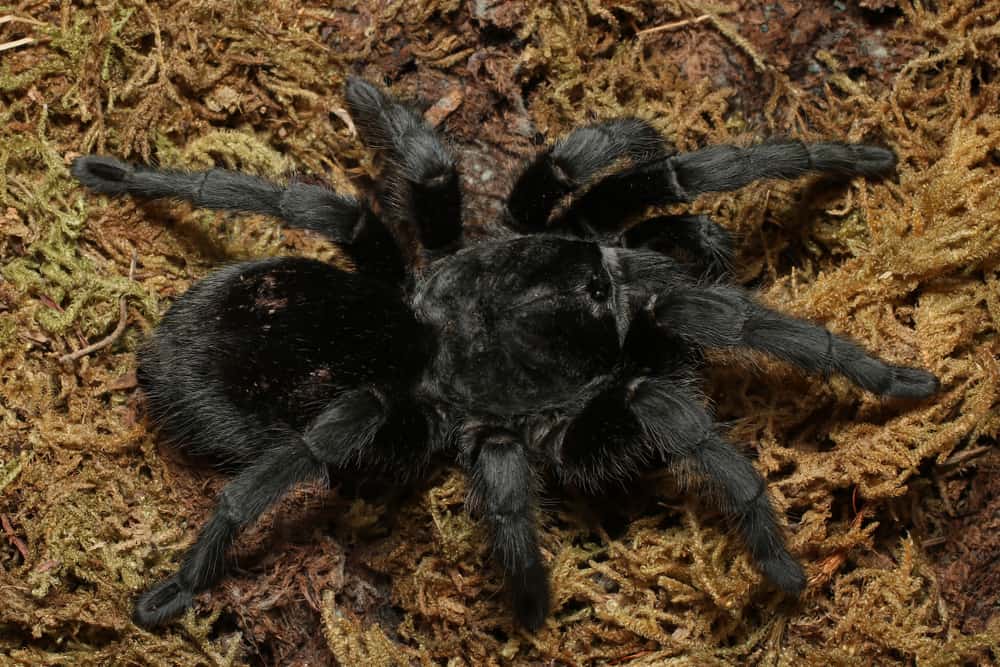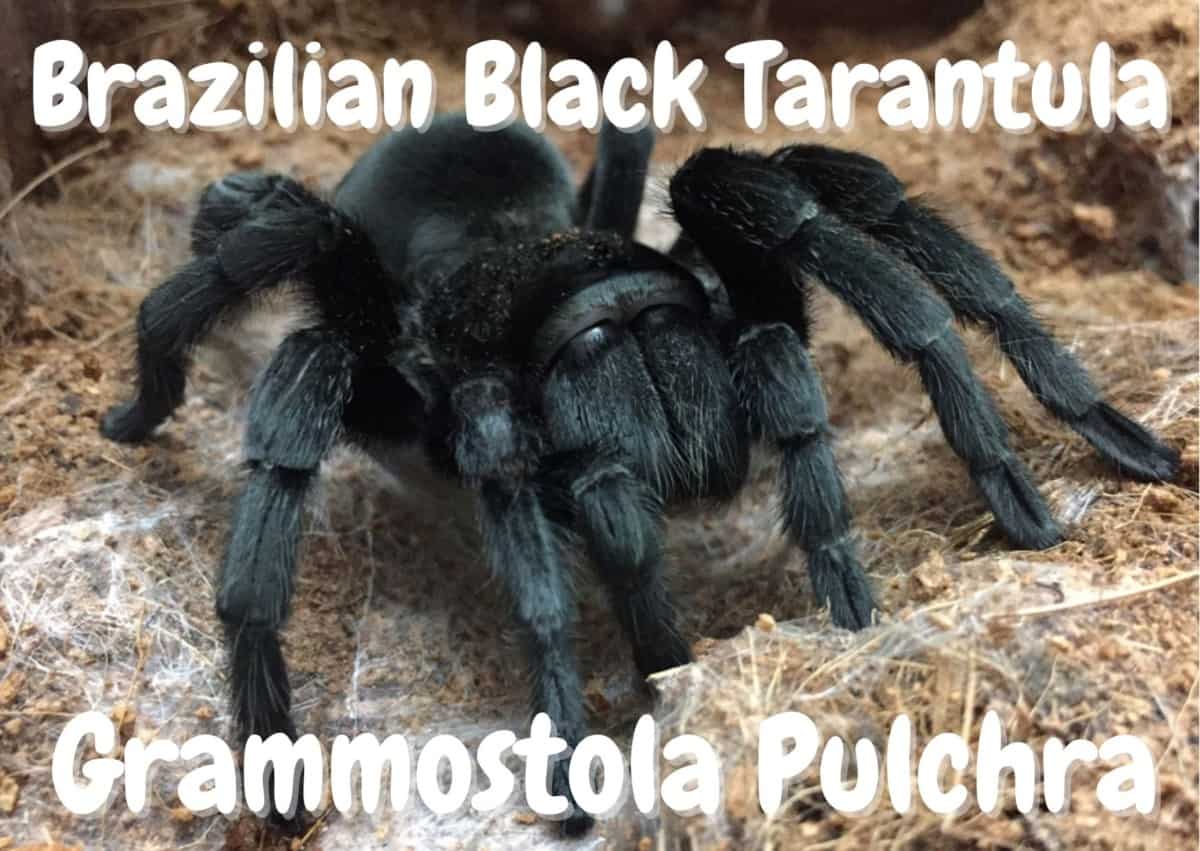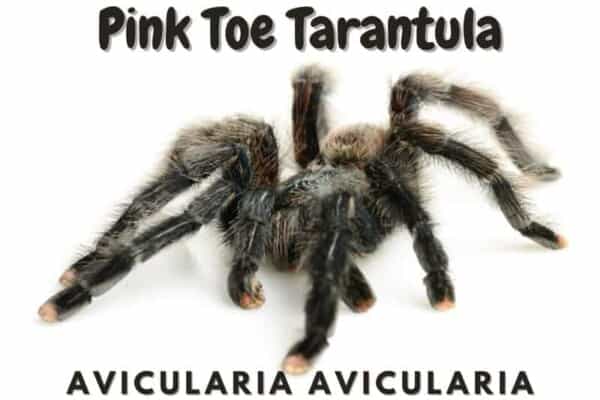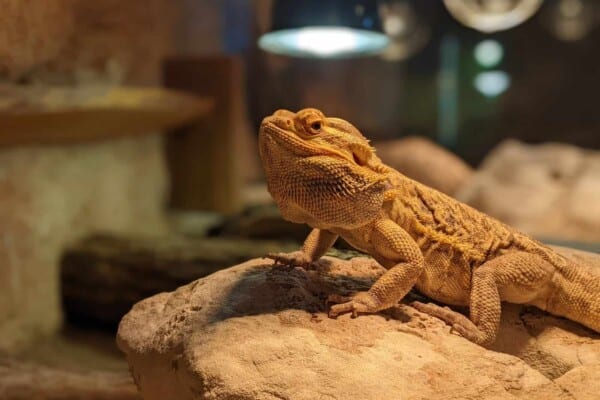The majestic Brazilian Black sometimes called the ‘Black Beauty’ is also known as Grammostola pulchra in the spider world. Since it’s so mellow for a big and soft spider, you might want to consider why they are perfect for keeping on any experience level.
Brazilian Black Tarantula Overview
| Scientific Name | Grammostola Pulchra |
| Dwelling | Terrestrial |
| Size | 6 to 7 inches |
| Lifespan | 5-6 years (male) / 25-30 years (female) |
| Food | locusts, grasshoppers, moths, pinky mice, small lizards |
| Difficulty | Beginner to intermediate |
Grammostola pulchra- Originally discovered and named by explorer Mello-Leitao (1921). There are already 11 other species in the Grammostola family.
Characteristics of the Brazilian Black Tarantula
This big black beauty has soft jet-black hair that evenly covers the legs and body. Aside from the velvet back color, it can also sport bluish-to-gray highlights on the tips of the legs. The abdomen or legs can look as if this Brazilian Black walked through blue-white metal powder.

Slings can appear as spiky little crawlers with radiating hairs making them appear like a walking sea urchin. Other slings will be evenly-covered soft hair spiders. The little slings will often look like an adult garden spider or the Tube trapdoor spider. These are part of the California mygalomorph spider family.
Size
Mature adults can get pretty big over the years. Overall they can reach 6-7 inches in length (15.24-17.78cm). As slings, these little ones measure 1.5cm (just under half an inch).
Temperament of the Brazilian Black
These are docile and easy-going tarantulas. Some owners will even go so far as to say they are the friendliest of the tarantula species. The Brazilian Black is least bothered when human contact is begun as slings. Adults are also non-threatened by exposure to being kept as a pet.
Lifespan
This species has a long lifespan and will live up to 30 years for females. The males live 8 years, but more often only 2-3 years due to mating attacks. Owners will need to be careful when pairing them for breeding.
Behavior
Despite their aggressive feeding habits and attitude towards their food, this species is remarkably calm and receptive to handling. This spider does not mind being held for short periods and rarely shows any kind of aggression toward people. It seldom flicks urticating hairs and does not rear up in defense. This is not to say that it can’t be provoked into a defensive mode.
Biting effects
While this spider does not show much interest in biting, all tarantulas must be handled carefully to avoid being bitten. Their venom is not dangerous for humans or has deadly side effects. The venom is similar to a bee sting with usual pain and stinging. Being bitten will hurt but the wound does need treating to prevent infection.
Difficulty of Care
This is an excellent beginner tarantula since they are so calm-natured. Their housing and feeding needs will be easy to handle as well if you follow daily and regular upkeep care. Middle schools especially like this species since they are friendly enough for young kids to learn about spiders. If you are just starting, this is a very good choice that is satisfying to own for years.
Housing the Brazilian Black Tarantula
Slings can enjoy a small 1-gallon tank with a snug-fitting lid for their first year. After that, you will need to upgrade to a 5 or 10-gallon tank enclosure. This spider likes to roam, so a longer length is advised. The tank itself needs to have proper lid fitting to make sure it cannot escape so easily also. Check the exotic pet store outlet near you (or online) for a tank that features side access windows.
This will make it easy to take your spider out when you need to. Make sure the enclosure is quality plastic or glass. If you prefer custom tanks, consult a professional who makes glass enclosures for exotic pet stores.
Cleaning
The one rule to follow when cleaning your spider housing is usually after they are fed. Since they tend to be hearty eaters they will leave empty bolus in the tank. It can be in one spot or all over the place. These need to be removed for bacterial reasons. Only feed your spider insects that are raised in captivity.
Outdoor cricket and cockroaches breed in environments that can carry mites and parasites into your enclosure so you should change the substrate at least once a month.
Accessories
This species is native to Brazil and Uruguay, so you can try to recreate their native environment as you like. Include plenty of ceramic items that can be suitable for hides. The Brazilian black tarantula is an avid opportunistic dweller in captivity. If they don’t feel like making a burrow they will simply find a suitable hide.
Give your spider obstacles to climb on, but nothing too high. Perhaps give them small ceramic logs and rocky hides. Many exotic pet stores will offer decorative terrarium walls. Why not try a nice exotic temple ruin with a rocky texture?
Humidity
You won’t need much when it comes to having the right humidity in the tank itself. A general spraying every day will keep the water vapor level at around 60-70%. The substrate doesn’t need to be overly moist either. Just make sure you have a hygrometer that tells you what the humidity level is. Spraying can be done in the afternoon each day and is enough to last a couple of days or more.
Temperature
Keep the optimal temperature inside the enclosure at 75-85F all year long. In the daytime, it can reach 85F. For nighttime temperatures, it can normally slip as low as 80F, but no lower than 75F. You might want to invest in a heating pad that has adjustable settings. You can slip this under the tank bottom. This explains why there is often an inch gap under certain glass tanks since it’s for heating pads.
Also, find a temperature sticker that monitors the glass temperature. This is a good indication of what the temperature inside the tank currently is.
Lighting
The Brazilian Black tarantula lives in jungles where light is not direct. It’s mostly shaded under the forest canopy. If you use any kind of light it will be to show off your spider for aesthetic reasons only. Choose a dimming LED light that has a color spectrum from 2000-2500K. This spectrum is closer to nature and has warmer sunset colors.
Substrate
In the wild, this species will burrow since the soil is soft and moist. Your enclosure doesn’t need to have a very wet substrate but will need preparation to make it desirable. Start with the important part that will give your spider cleaner materials that go in. You need to dry out and make the soil and moss sterile. This means it needs to have no bacteria in it.
Most soil (even gardening soil) will contain all sorts of living things. Even dried moss and coconut fiber will have varieties of things that can re-hatch as dormant eggs too. Once mixed, this needs to go into an oven and be baked. Two pounds of material can take up to 1 hour at 150F. This will take time so make plenty to spare for monthly cleaning.
Store the extra substrate in 5-gallon drums that can be sealed to keep it dry. When you finally add this to the tank, give your spider about 3-4 inches. Mature females might like up to 8 inches if they’re into burrowing a lot.
Feeding the Brazilian Black Tarantula
Locusts and grasshoppers are good food sources. Don’t use crickets since these can be real pests to this spider. Dubia cockroaches and mealworms are also good choices. They have been known to eat pinky mice and even small lizards. You can even try moths as these will be hunted at night. The smaller spiderlings will eat little mealworms, small headless crickets, and fruit flies.
How often does the Brazilian Black tarantula need food?
Mature adults have a very healthy appetite and can eat up to 5 locusts a week. Spiderlings will eat twice a week, but less when they are getting ready to molt. Don’t feed them after they molt, since they will need to dry their exoskeleton for a couple of days. Adults need a couple of weeks or more after molting too. Remove any insect that has not been consumed and always remove dead insects that are drained right after feeding.
Drink
Find the right size cap or lid that fits the size of your spider. Little ones can be fine with twist-off caps like Snapple or V8, while adults will like the larger jelly jar or pickle jar-sized lids. They need to be shallow to walk over. Be sure to sink them into the substrate so they don’t get knocked over.
Handling the Brazilian Black Tarantula
Always use slow and calm movements to move your spider. A gentle nudge on the abdomen is all that is needed to get them moving. They don’t seem to mind this action and won’t run away like other spiders usually do. As long as you are nice to them, they are good-natured in return.
Make sure you are sitting on a soft carpet if you do handle them. Any fall from 1 meter or less can be dangerous to their abdomen or carapace. In the event you are bitten, do not react suddenly. Put them down to the floor and put a bowl over them to keep them from escaping. Then treat your bite properly.
Common health problems encountered by the Brazilian Black T
Proper hydration is important to their survival, so making sure they have water is equally important. Even if you never see them going to the water dish, they will find other ways to drink. The afternoon sprays in the tank will give them a chance to get moisture off the glass. If you have sterilized the substrate properly there will be no problem with molds, fungus, or mites.
Molting is the only threat for them that you might think is a concern. It wouldn’t hurt to raise the humidity a bit higher to help them exit their exoskeleton sooner.
Breeding the Brazilian Black Tarantula
This will be difficult at first since this species is harder to reproduce than others. These spiders reach their final molt into adulthood later than most species. Males take 5-6 years while females can take up to 8 years. It’s a long hard road to get to their breeding point.
When they can be paired, they will be calm and relaxed about it. Mating can take up to 10 minutes with the male being extra careful to get his sperm silk properly inserted.
Up to 12 weeks later the female will produce an egg sack that is lined with silk. She will incubate this the whole time and will protect those eggs fiercely. She must be fed well at this time. Experts believe this helps her not to consume the eggs. She will not leave her den until they have hatched.
How many eggs does the Brazilian Black lay?
The total count is unsure, but private breeders have counted 100-150 eggs in a cocoon sack. In the wild, it can be as many as 600. Spiderlings that hatch will immediately start feeding on unhatched eggs. If you are lucky to remove an egg sack without harm to your female spider, you can incubate them until they hatch.
What to do with the spiderlings
Since this species is not so easy to breed in captivity, every buyer in the world will want to buy these slings. Depending on what kind of color your tarantula is, you might have even more selling potential. They can also be sold through the internet at very profitable amounts per spiderling.
Availability of the Brazilian Black Tarantula
You can expect prices as high as 100 dollars for a one-inch sling!
While they are sold all over the world, they aren’t so easy to buy cheaply. For this reason, the best place to find these species is at spider expos and exotic pet exhibitions.
You can meet with owners and possibly buy a sling at half the price. The specialty pet stores will always have higher prices since they know this one is already in high demand.
Resources and further reading:
- An integrative approach for species delimitation in the spider genus Grammostola (Theraphosidae, Mygalomorphae), Laura Montes de Oca, Guillermo D’Elía, Fernando Pérez-Miles
Contents
- Brazilian Black Tarantula Overview
- Characteristics of the Brazilian Black Tarantula
- Housing the Brazilian Black Tarantula
- Feeding the Brazilian Black Tarantula
- Handling the Brazilian Black Tarantula
- Common health problems encountered by the Brazilian Black T
- Breeding the Brazilian Black Tarantula
- Availability of the Brazilian Black Tarantula













